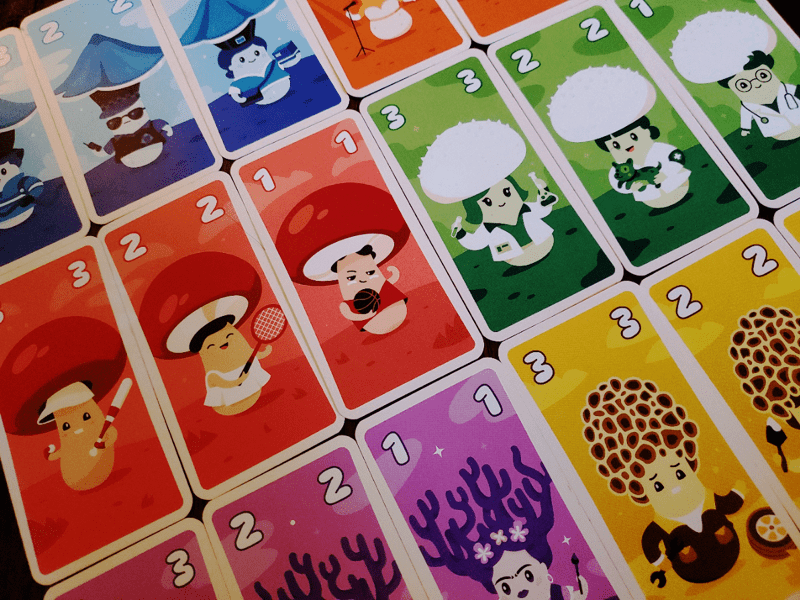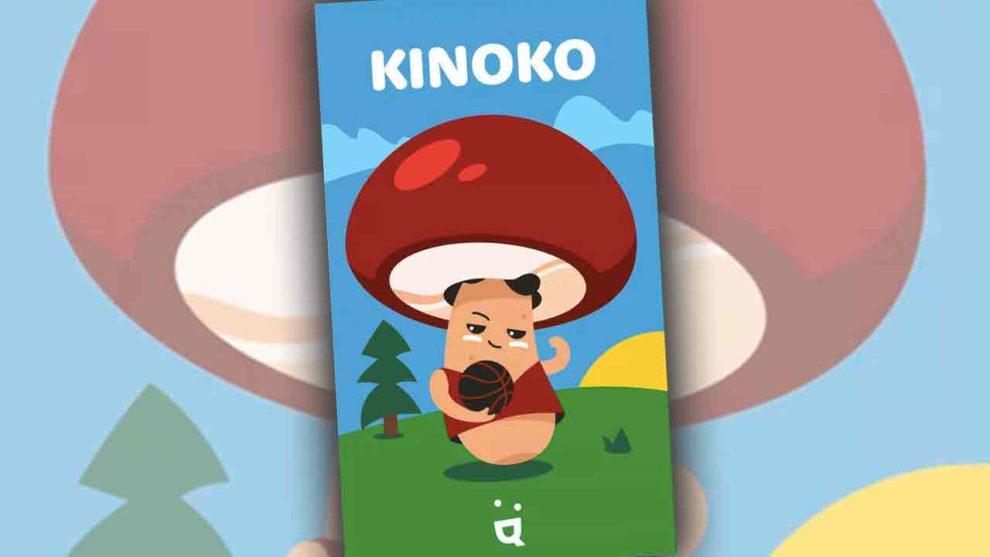Disclosure: Meeple Mountain received a free copy of this product in exchange for an honest, unbiased review. This review is not intended to be an endorsement.
Imagine with me the gravity of sitting down to a table for an exercise in social engineering. There are six spheres of children in need of companionship, and you’ve been given the task of bringing them together. Because this is a competitive endeavor, you must accomplish the task before everyone else. However, you’ll have to start by finding them all.
Of course, these are no ordinary children. They are children of the trees, Kinoko. Translated to English? They’re mushrooms. Goofy looking mushrooms. Wait a minute, is that mushroom holding a basketball? What sort of game is this?!
Kinoko is a tiny box game from Helvetiq and the mind of Tim Rogasch in which players attempt to bring families of mushrooms together based on their common interests. Let’s find out what can be done with 24 cards, a few dice, and almost as many linguistic variations of the rulebook as there are scoring tokens.
There are 8,000 types of mushrooms in the world
The cards of Kinoko come in six varieties: Athletes (Red), Musicians (Orange), Artisans (Yellow), Scientists (Green), Public Servants (Blue), and Artists (Purple). Their occupations couldn’t matter less in terms of gameplay, but my goodness do they keep the game bubbly. Each color has a set of numbers, one through three. Players receive one of each number, but the cards remain ultra top-secret and face down. Leftover cards are dealt into two face down hands in the middle of the table.
Players must never begin with knowedge of the cards in their own hands, so cards are held face out. The card backs reveal number, but not color.

There are also six cards that generically display color without a care for occupation. Each player receives one, also face down. This card, however, comes with peeking privileges as it will be the 1-2-3 set the player is attempting to assemble somewhere on the table. One of the leftover cards is flipped over to reveal the forbidden color—the apparent social outcast—for the round.
On each turn, players (keeping those cards outward) roll the three dice and choose one action. If a number is chosen, players may swap any two cards of that number at the table. Player to player? Sure. Player to face down hand on the table? Yes. Their own cards? You bet.
There are also three symbols. One allows a Peek at one card, one allows a Reroll of the dice, and the last allows for a wholesale swap of a hand of cards. Finally, there are several blank sides just to create discomfort.

When a player believes they’ve created a set, they stop the game in some dramatic fashion and reveal their hidden objective mushroom. If that set exists, two points for Gryffindor! If not, one point for everyone else! If anyone is holding any forbidden cards, they’ll lose one point. The game ends when someone reaches four. It’s that simple.
This would be a great place for a fun-guy pun
Obviously, Kinoko is indebted to Hanabi, the game that made hidden information games explosively cool. But this is no mere knock-off; the mushrooms bring interesting things to the table. I can think of three:
Facial control. One rule we’ve typically broken is continuing a round as normal even when a player is dealt a natural set, though the rules suggest reshuffling and starting over. Though it presents an unfortunate reality, we’ve appreciated the added element of restraint. When a player is dealt a set outright, there must be a hint of control in the matter of eye wrinkles and lip curls as the other players either try to disassemble the set or capitalize on the good fortune. When a player is dealt a set of the forbidden card, regardless of how much you want to, you really shouldn’t laugh at them. Most obviously, when a player acquires the set unwittingly after a maneuver or two, the same ideas apply.
Memory. Remembering your own hand is manageable. Holding the cards from left to right, you just have to keep a tally of colors in your mind as you trade and learn. But those two hands of cards in the middle of the table? They hurt my brain. Ok, the blue two is there, and the green three is over there, and was that a purple one? Was that three orange or red? O why did I look away for that bite of cake? Curse you Betty Crocker!!
Danger. Knowing when to make your suit of interest known is the game’s tactical dish. Seeing all three of your cards out in the fresh air is tempting. You could, with your first move, put two of them together, unleashing a cat and mouse game as others then torture you as they shift and shuffle cards to their advantage. If I’m being honest, you should put those cards together. It’s just more fun that way. Plus, let’s not forget that building a set somewhere other than your own hand might mean that you’re holding the dreaded forbidden cards without realizing.

I’ve played with the family. They love it. In one game, our youngest—who is admittedly a little loose with her cards—revealed to the table that she wanted orange (the musicians, in case you’ve forgotten). The great fun of that hand was keeping a straight face as she held all three orange cards in her hand, frantically searching for them elsewhere. Someone rolled a wholesale swap and, in mercy, traded with her. Her face was priceless. There is solid family fun here.
I’ve played with friends. The adult game can stretch beyond the expected 20 minutes, depending on the level of tactical consideration in play. We finished 5-3-2-2 on the scoreboard in our most recent effort. There were risky stops with incorrect guesses and points for all. There were deviously planted forbidden cards, sets formed in the open, sets kept in hiding—nearly everything I’d imagine the folks at Helvetiq wanted us to experience. We celebrated the hilarity after finishing up a longer strategy game and talked about it more than the heavier fare.
I’d imagine this one will stay with us until we wear the cards out. Kinoko travels easy, teaches easy, and makes my brain uncomfortable in the most refreshing way. Helvetiq has a low-key winner with this one.












Add Comment